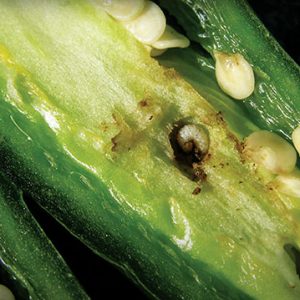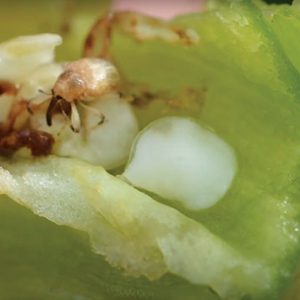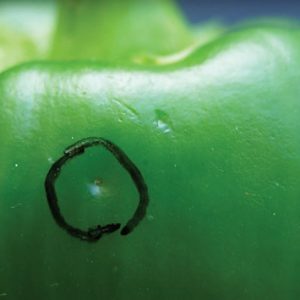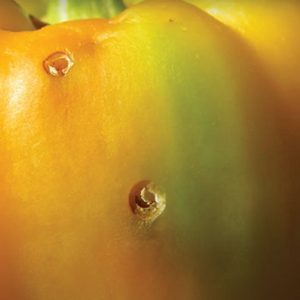
Features
Crop Protection
Monitoring for pepper weevil
How to set traps, identify and scout for the pest.
June 8, 2021 By Cara McCreary, Cassandra Russell and Amanda Tracey
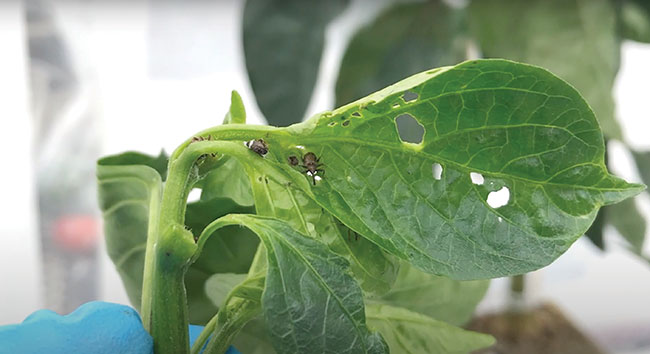 As pepper weevil is diurnal, monitoring for adults should occur in the daytime. All photos: GreenhouseIPM.org
As pepper weevil is diurnal, monitoring for adults should occur in the daytime. All photos: GreenhouseIPM.org
Pepper weevil is an economically damaging pest of greenhouse and field peppers. Successful management begins with diligent monitoring programs aimed at early detection followed by a rapid response.
Here’s how you can monitor for pepper weevil inside and outside of the greenhouse, using pheromone-baited sticky traps and proper scouting practices.
Pheromone-baited traps
The most reliable tool to assist with early detection is a pheromone trap, which often consists of a large yellow sticky card and pheromone lures. These lures contain chemical compounds that work as aggregation pheromones to attract both male and female adult pepper weevil.
In greenhouses, traps should be set up around the outside perimeter of the greenhouse and inside the pepper crop. Traps should be in place as soon as the new crop is planted, but they can also be used in a clean, empty greenhouse before planting to capture any residual weevils.
For greenhouse use, a minimum of ten traps per hectare, or four traps per acre, is recommended. Increasing the number of traps can improve the likelihood of early detection.
There are kits available for setting up pheromone traps. In the accompanying video to this article on GreenhouseIPM.org, the kit being shown uses a large yellow sticky card with one hole on the bottom and three holes at the top.
For use outside, begin by placing the bottom of the stake through the bottom hole of the large yellow sticky card. Remove the paper from the top down on both sides just enough to reveal the three holes at the top of the yellow sticky card and slide the top of the card through the top loop of the stake.
This particular kit also contains two different lures. The first lure is a long clear tube with a cap on the end. Leave the cap closed and slide it into one of the outside holes on the top. Carefully slide the second rubber lure into the outside hole on the opposite side. Lastly, remove the rest of the paper coverings and place the stake in your desired location. In the field, this should be at plant height.
For placement inside a greenhouse, use a twist tie or clip to secure it to a wire or post.
The pheromone lures should be stored in a refrigerator prior to use and placed in a cooler during transport.
Identification
Once set up, be sure to check the traps once or twice per week.
If you spot a weevil caught on the sticky card, it is important to properly identify it. Use a hand lens to get a closer look at the captured insects, which may include other weevil species.
Understanding pepper weevil’s distinguishing features can help with identification. These features include: a long snout; strongly arched body; white or yellowish scales covering the thorax and elytra; mahogany to nearly black body; spurs on all six legs; and a circular concentration of scales just above the elytra.
If you are unsure or want confirmation, reach out to a trusted IPM specialist or send it to an identification service.
Refer to Greenhouse Canada’s June 2020 edition for a detailed guide on weevil identification, entitled “How to know when your weevil is evil.”
Scouting
Once an adult pepper weevil has been identified on the trap, it’s important to conduct more thorough plant inspections.
Focus your monitoring efforts on inspecting smaller fruit and buds, where females prefer to lay their eggs, as well as larger fruit, aborted fruit, foliage, and stems.
Damage may include dimples or egg-laying scars in the fruit, yellow calyxes, circular exit holes, and holes in flowers and leaves.
Be sure to inspect flowers and young folded leaves for adult pepper weevil. Pepper weevil are diurnal, so monitoring for adults should be restricted to daytime.
If any symptoms of infestation are observed on the outside of the fruit, the pepper can be carefully cut open to look for signs of pepper weevil on the inside.
Behind the egg-laying scar will be egg tissue. Inside there may be larvae, pupae, or a new adult, and signs of feeding such as blackened seeds and cores.
If you spot any infested fruit, be sure to remove it promptly and properly discard it.
To avoid re-infesting greenhouses or fields, do not pile or spread infested peppers or plant material near the crop. Check with your grower organization or local specialists for disposal recommendations.
Being proactive and diligent with your monitoring efforts will allow you to catch infestations early, improving your ability to manage pepper weevil and reduce crop losses.
This article accompanies one in a series of videos on GreenhouseIPM.org, generously funded by the Canadian Greenhouse Conference, with support from Greenhouse Canada and Flowers Canada.
Cara McCreary is the greenhouse vegetable IPM specialist, Cassandra Russell is former acting vegetable crop specialist, and Amanda Tracey is a vegetable crop specialist at the Ontario Ministry of Agriculture, Food and Rural Affairs.
Print this page
